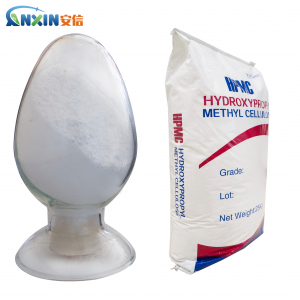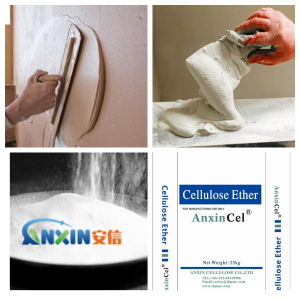Hydroxypropyl methylcellulose (HPMC) is a non-ionic cellulose ether widely used in building materials, especially playing a crucial role in gypsum-based building materials. With the promotion of green building and energy-saving materials, HPMC has become an indispensable high-performance additive in gypsum building material systems due to its excellent thickening, water retention, workability control, and interface improvement properties.
1. Mechanism of Action of HPMC in Gypsum Systems
1.1. Enhanced Water Retention
After construction, gypsum materials need to undergo a hydration reaction to form dihydrate gypsum crystals, thereby forming structural strength. However, gypsum sets relatively quickly; if water loss is too rapid, it will cause surface cracking or insufficient strength. HPMC, by forming a three-dimensional network structure in the system, significantly improves water retention capacity, reduces water evaporation and infiltration loss, thereby ensuring sufficient gypsum hydration. This characteristic is particularly important in dry environments or in construction on highly absorbent substrates.
1.2. Rheological Property Adjustment
HPMC solution exhibits significant pseudoplastic fluid characteristics, meaning its viscosity decreases under shear and recovers to a high viscosity upon settling. This allows the gypsum slurry to flow smoothly and be easily spread during mixing or application, while quickly regaining its consistency after settling, preventing sagging and bleeding. This improves workability and enhances the uniformity of the coating thickness.
1.3. Improved Workability and Delayed Setting
Appropriate amounts of HPMC can slow down the hydration rate of hemihydrate gypsum, extending the open time and making application more manageable. The coating effect of HPMC molecules on gypsum crystal nuclei effectively regulates the crystallization rate, preventing cracking and sticking problems caused by excessively rapid early setting.
1.4. Enhanced Adhesion and Crack Resistance
HPMC forms a flexible film in the hardened gypsum system, improving the interfacial adhesion between the gypsum and the substrate or insulation board. Simultaneously, this organic polymer network can alleviate stress concentration at the microscopic level, reducing the risk of shrinkage cracks.
2. Applications of HPMC in Different Gypsum Building Materials
2.1. Gypsum Plastering Mortar
In gypsum plastering mortar, the main function of HPMC is to adjust the consistency and water retention, giving the mortar excellent adhesion and ductility on the wall surface. High water retention ensures full hardening of the gypsum, preventing powdering. Simultaneously, HPMC improves the surface smoothness of the mortar and increases construction efficiency.
2.2. Gypsum Leveling Layer and Putty
For gypsum-based putty or leveling materials, HPMC not only improves the flowability of the workpiece but also enhances adhesion and surface density, resulting in a smooth, crack-free coating. HPMC of different viscosities can be flexibly selected according to the application thickness and construction method; high-viscosity products are suitable for thick-layer leveling, while low-viscosity products are more suitable for thin-layer application.
2.3. Gypsum Adhesives
Gypsum adhesives used for bonding gypsum boards or insulation boards require good workability and bond strength. HPMC, by regulating hydration rate and improving thixotropic properties, prevents the adhesive from slipping during vertical application and ensures full contact with the substrate, thus improving adhesion.
2.4. Self-Leveling Gypsum
Self-leveling gypsum requires excellent flowability and stability. HPMC plays a crucial role in such systems by controlling flow viscosity, preventing bleeding and segregation, and, in synergy with dispersants, ensuring a smooth and dense surface after application.
3. Key Factors Affecting HPMC Performance
3.1. Substitution Degree and Viscosity
The degree of substitution of HPMC with methoxy and hydroxypropoxy groups directly affects its solubility and water retention. Generally, products with medium to high substitution degrees have better water retention. Higher viscosity indicates stronger water retention and consistency, but excessive viscosity may lead to insufficient flowability during application; therefore, optimization and matching are necessary based on different gypsum formulations.
3.2. Dosage Control
The typical dosage of HPMC in gypsum building materials is 0.1% to 0.3%. Excessive dosage may lead to excessively long setting time or excessively high viscosity, affecting construction efficiency. In actual production, the optimal dosage should be determined through experiments based on climatic conditions, gypsum type, and construction requirements.
3.3. Compatibility with Other Additives
HPMC is often used in combination with starch ethers, retarders, and redispersible latex powders. Proper combination can further improve rheological properties and crack resistance, but attention should be paid to the impact of interactions on setting time and apparent properties.
4. Future Development Trends
With increasing requirements for building energy conservation and environmental protection, the application scope of gypsum-based materials continues to expand, and the functional requirements of HPMC are becoming more diversified and demanding. Future research and development directions include: High water retention, low dosage HPMC to reduce costs and simplify formulations; Functionalized modified HPMC, endowed with stronger alkali resistance and anti-aging properties through molecular structure design; and compound systems with green additives to achieve a better construction experience and sustainable development.
HPMC in gypsum building materials is not only a simple thickener, but also a key functional component for controlling system stability, construction performance, and final structural quality. Through scientific selection and precise proportioning, HPMC can significantly improve the overall performance of gypsum materials, providing solid technical support for high-quality, low-energy, and sustainable modern buildings.
Post time: Nov-03-2025








